#23: Photosynthesis (Light Reactions)
1/97
Earn XP
Description and Tags
Name | Mastery | Learn | Test | Matching | Spaced |
|---|
No study sessions yet.
98 Terms
Photosynthesis combines _____ and _____ to make ______________ and ____
CO2, H2O, carbohydrates, O2
Photosynthesis is a huge _____________ reaction, as opposed to the huge ___________ reaction of glucose breakdown
reduction, oxidation
Is photosynthesis an OXIDATION reaction or a REDUCTION reaction?
reduction
photo = ______
synthesis = _________ __________ in organic molecules
light, carbon fixation
Photosynthesis occurs in _________, ________, and some ______________
plants, algae, bacteria
Photosynthesis takes the waste products of ____________ (_____ and ______) and uses the energy of the _____ to generate ____________ and ____. This is the exact ____________ of what animals do. Ultimately, through photosynthesis, the _____ powers nearly all life on Earth.
respiration, CO2, H2O, sun, carbohydrates, O2, opposite, sun
Photosynthesis regenerates the _____________ of __________ _______________: ______________ and _____
reactants, oxidative phosphorylation, carbohydrates, O2
What is the immediate product of photosynthesis?
glyceraldehyde-3-phosphate
The _____/_____ _______ between plants and animals contributed to the discovery of photosynthesis.
Joseph Priestly (1733-1804) found that plants help _________ _______ and animals stay ________ in sealed containers.
Plants make ____ _________ when submerged in water and exposed to light (Ingenhousz, 1770s)
For plants to gain ______, both ____ and ____ are required (se Saussure, early 1800s)
Isolated ___________ can drive ________________ ____________ _______ reactions when irradiated by light (Hill, 1939)
O2/CO2 cycle, candles burn, alive, O2 bubbles, mass, CO2, H2O, chloroplasts, thermodynamically unfavorable redox
Photosynthesis, which is the complete _________ of the ___________ of glucose, requires the same amount of ________ (which is a rather large amount)
reverse, oxidation, energy
How much energy is required for photosynthesis? (aka what is the standard change in free energy)
+2870 (kJ/mol)
What is the simplified version of the overall photosynthesis reaction?
6CO2 + 6H2O -> C6H12O6 + 6O2
Where does the energy it takes for photosynthesis come from?
the sun
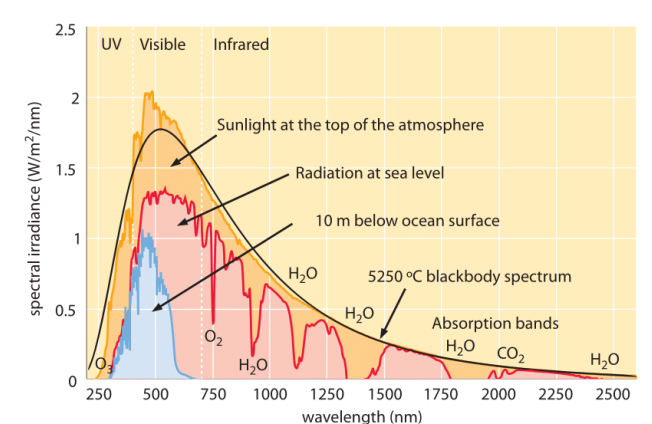
Of the various light absorptions shown, which one matches what we see on the surface of the earth? (name the color)
red
A mole of photons at a wavelength (λ) = 600nm has ~ _____ kJ of energy while the standard free energy change for ATP hydrolysis releases _______ kJ/mol of energy. These numbers are at roughly the same _______________, so there is enough energy in a mole of photons at a wavelength of 600nm to probably make a few _____.
200, -30.5, magnitude, ATP
There is a relationship between ______________ (or ____________) and the energy of those ___________: as ______________ decreases, the ____________ and ___________ of those __________ increases.
wavelength, frequency, photons, wavelength, frequency, energy, photons
What physicists refer to as __________, other people might just call ______. As quanta of ______, __________ are the smallest possible packets of electromagnetic energy.
photons, light, light, photons
The sun produces more energy in a single _________ than humanity has ___________ in its entire ____________
second, consumed, existence
Light reactions require ________ ________ as an energy source and produce __________ _________ (in the form of __________), ______, and _____.
visible light, reducing power, NADPH, ATP, O2
Light reactions = The light ______ that comes into the _____________ is used to split ______ and pull ___________ out of it and ___________ it to ____. The energy from the __________ first makes ____ and then ________ it in ________.
energy, chloroplast, water, electrons, oxidize, O2, electrons, ATP, stores, NADPH
What is the overall equation for the light reactions of photosynthesis?
2H2O + 2NADP+ + 3ADP + 3Pi + light -> 2NADPH + 2H+ + 3ATP + O2
What is another name for the carbon fixation reactions in photosynthesis?
calvin cycle
________ and ______ drive the carbon reactions, which occur in both the ___________ and __________ of ________ and ____ ____ into ________________.
NADPH, ATP, presence, absence, light, fix CO2, carbohydrates
What is the overall equation for the carbon reactions of photosynthesis?
3CO2 + 9ATP + 6NADPH + 6H+ -> C3H6O3-phosphate + 9ADP + 8Pi + 6NADP+ + 3H2O
Carbon reactions = Uses the __________ (_____) produced by the light reactions and the __________ _________ that we’ve stored in ___________ to _____ __________ and synthesize ________________.
energy, ATP, reducing power, NADPH, fix carbon, carbohydrates
What are the REACTANTS of the LIGHT reactions of photosynthesis?
2H2O, 2NADP+, 3ADP, 3Pi, light
What are the PRODUCTS of the LIGHT reactions of photosynthesis?
2NADPH, 2H+, 3ATP, O2
What are the REACTANTS of the CARBON reactions of photosynthesis?
3CO2, 9ATP, 6NADPH, 6H+
What are the PRODUCTS of the CARBON reactions of photosynthesis?
C3H6O3-phosphate, 9ADP, 8Pi, 6NADP+, 3H2O
What is the photosynthetic organelle?
chloroplast
How many membranes do chloroplasts have?
Name them.
3, outer, inner, thylakoid
Absorption of light and all light reactions occur within or on the ______________ ____________ of chloroplasts. Biosynthetic carbon reactions take place in the __________.
thylakoid membranes, stroma
The chloroplast _________ is analogous to the mitochondrial matrix. The __________ __________ is “outside” the _________. We will be pumping _________ out of the __________ and into the ___________ ________.
stroma, thylakoid lumen, stroma, protons, stroma, thylakoid lumen
The chloroplast ____________ ___________ is analogous to the inner mitochondrial membrane.
thylakoid membrane
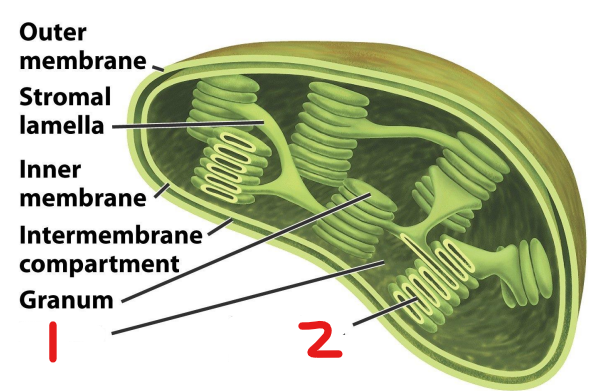
What is indicated by #1?
stroma
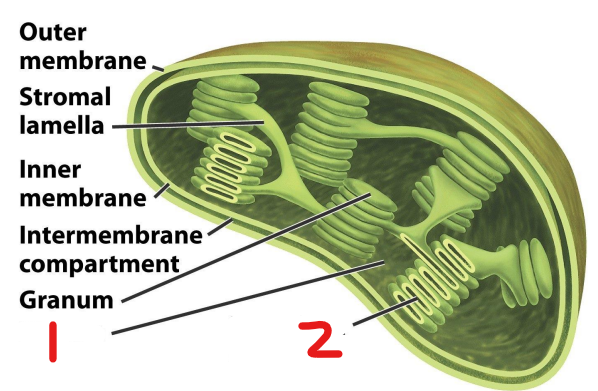
What is indicated by #2?
thylakoid lumen
The __________ ___________ used for ___________ __________ in photosynthesis are similar to those used in cellular respiration.
protein complexes, electron transfer
How many transmembrane protein complexes are in the ETC in MITOCHONDRIA? Name them.
How many transmembrane protein complexes are in the ETC in CHLOROPLASTS? Name them.
4, complex I, complex II, complex III, complex IV, 3, PSII complex, cytochrome b6f, PSI complex
How many soluble electron carriers are in the ETC in MITOCHONDRIA? Name them.
How many soluble electron carriers are in the ETC in CHLOROPLASTS? Name them.
2, Q, cytochrome c, 2, plastoquinone (Qb), plastocyanin (PC)
In MITOCHONDRIA: protons pumped out of the _________ flow back down through ______ ___________.
In CHLOROPLASTS: protons pumped out of the _________ flow back down through ______ ____________.
matrix, ATP synthase, stroma, ATP synthase
The starting reaction of electron transport in chloroplasts (__________ → _______________) is the exact ___________ reaction of the ___________ ___________ ___________ reaction in mitochondria (______________ → __________).
2H2O -> 4H+ + O2, opposite, terminal electron acceptor, 1/2O2 + 2H+ -> H2O
_________________ (____) in chloroplasts is analogous to ubiquinone (Q) in mitochondria. It is located in the ___________ __________ bilayer.
plastoquinone, Qb, thylakoid membrane
_________________ (_____) in chloroplasts is analogous to Cytochrome c (Cyt c) in mitochondria. It is bound _________ of the _________.
plastocyanin (PC), outside, stroma
What is the order of how electrons move in the thylakoid membrane?
PSII complex, Qb, cytochrome b6f, PC, PSI complex, ferredoxin
The light reactions use ______ energy to extract ___________ from ________ to store energy in _____ and _________ ________ in _________. ____ is a byproduct.
light, electrons, H2O, ATP, reducing power, NADPH, O2
Chloroplasts store _________ _________ in NADPH because in order to make ______________, you have to _________ ______ up to the _______________.
reducing power, carbohydrates, reduce CO2, carbohydrate
Photosystem II (PSII) is a large, _____________ complex that includes many ___________ molecules. Each PSII contains over ____ _____________. This core complex is surrounded by _________ _____________ complexes with tons of additional ____________. They act like a big _______ _______ surrounding PSII. ____ and ____ are the reaction center subunits where the business happens. There is a pair of ____________ sitting in the ________ _______ of the reaction centers and is referred to as the __________ _______ or ________.
multiprotein, pigment, 30 chlorophylls, light harvesting, pigments, solar panel, D1, D2, chlorophylls, active site, special pair, P680
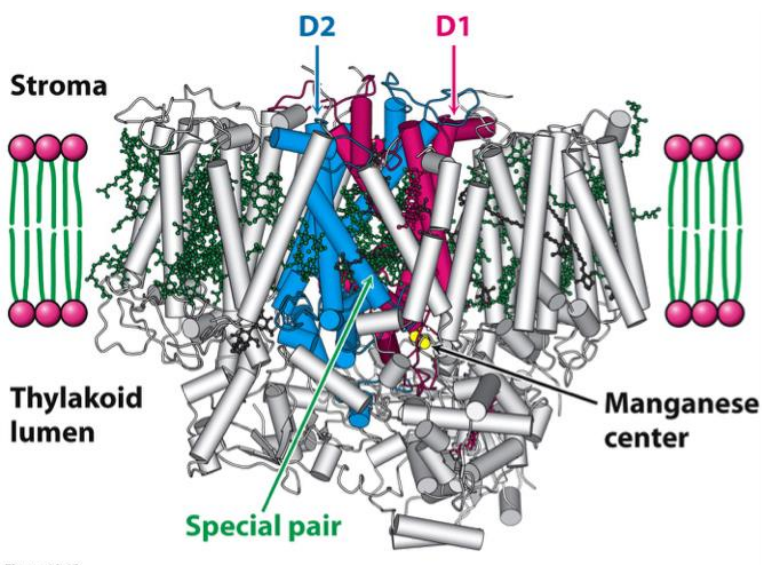
What is this a picture of?
photosystem II (PSII)
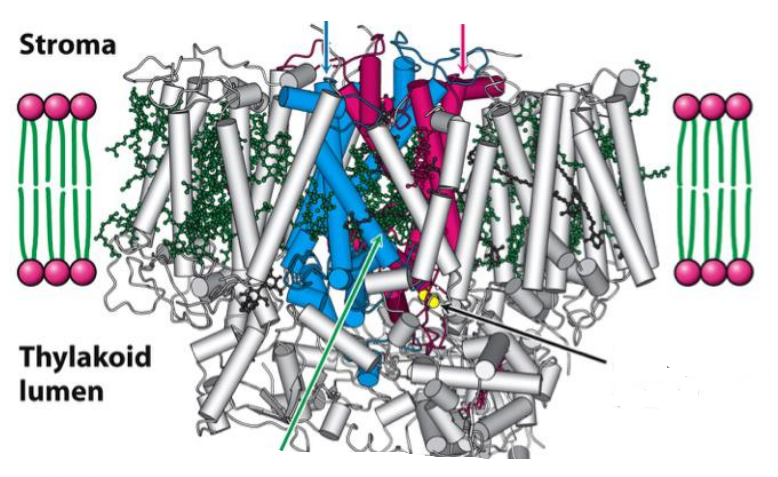
What is this a picture of?
What is the BLUE arrow pointing to?
PSII, D2
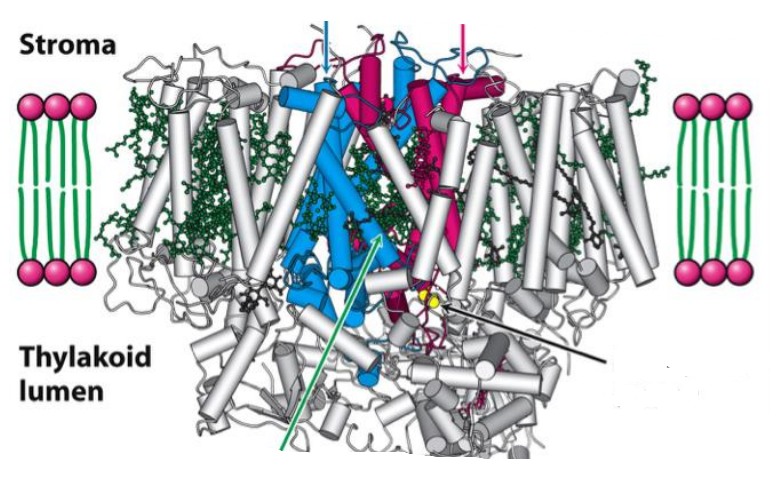
What is this a picture of?
What is the PINK arrow pointing to?
PSII, D1
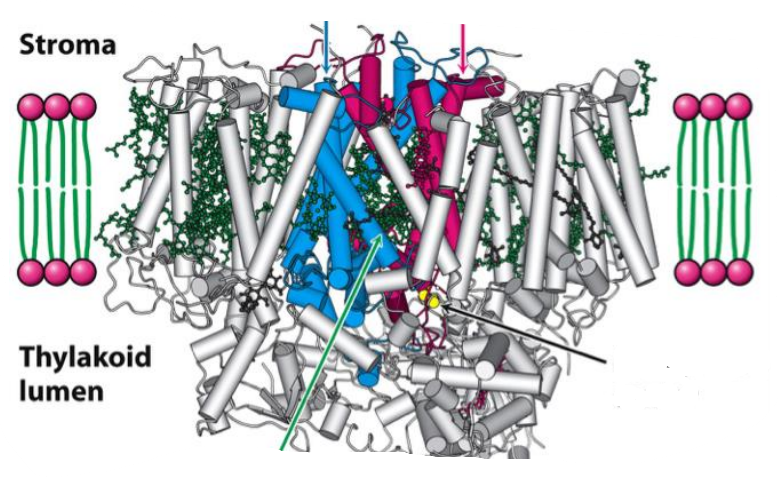
What is this a picture of?
What is the GREEN arrow pointing to?
PSII, the special pair of chlorophylls (P680)
The ________________ ___________ within PSII are built to _________ _________ in the visible spectrum. There are ____ types of _____________, ___ and ___ being the most abundant. They differ only at a single carbon group, with ___ having ______ and ___ having ______. _______________, ______________, and ______________ are accessory _________ that are less abundant.
photosynthetic pigments, absorb light, 5, chlorophylls, a, b, a, Ch3, b, CHO, carotenoids, phycocyanin, phycoerythrin, pigments
What part of the pigment structure makes pigments so great at absorbing visible light?
conjugated rings
chlorophylls are a type of ____________
pigment

What is this a picture of?
chlorophyll

What is this a picture of?
carotenoid (specifically beta-Carotene)
Why do plants have so many pigment molecules?
There is a strong _______________ drive for plants to be able to ________ as much ________ as possible.
Different types of pigments __________ ______ at different ____________.
Having a large number of pigment molecules ensures plants have efficient ________ capture by “_________ ___ _______ ____”, both in the wide array of _____________ they are able to _______ ________ at but also in the literal _________ of pigment molecules in the complexes. _______ energy bounces from pigment to pigment until it reaches the _________ ______ (_______) via __________ _________. This is super _______.
evolutionary, absorb, light, absorb light, wavelengths, light, casting a wider net, wavelengths, absorb light, number, light, special pair, P680, resonance transfer, fast
NADPH is generally used for ____________ processes (building something up) whereas NADH is generally used for ____________ processes (breaking something down)
anabolic, catabolic
______ is the source of electrons and ______ is the source of carbons for photosynthesis
H2O, CO2
Unlike in the mitochondria, the chloroplast ETC actually has electrons moving ________ in ________ and it is able to do this because at 2 different places (______ and _______) _________ ________ is provided (produces the “Z scheme”)
uphill, energy, PSII, PSI, light energy
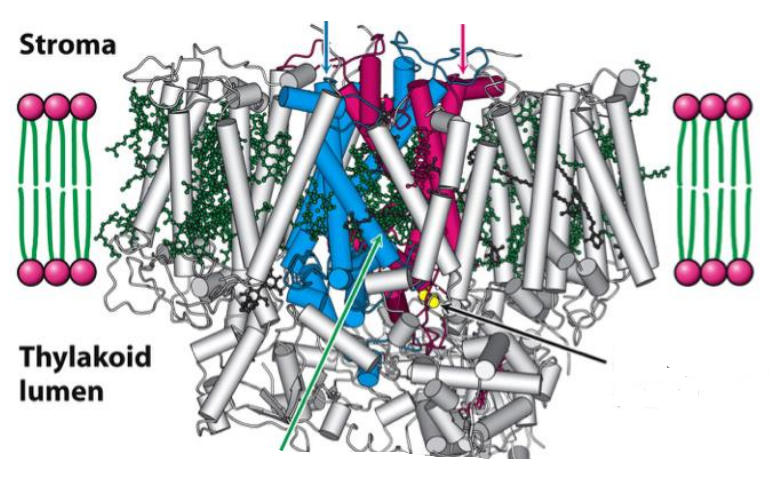
What is this a picture of?
What is the BLACK arrow pointing to?
photosystem II (PSII), manganese center
What metal is found at the center of chlorophylls?
magnesium (Mg)
In Photosystem II (PSII), the _________ makes its way to _______ (aka the _________ _________) via _________ _________ and _______ one of its electrons. Once the ________ reaches _______, it can’t leave. This ________ electron leaves _______, creating _______, and gets transferred to ______________ (aka the primary _____________). It then gets transferred to _____ which remains attached to _____ and then to _____. Once ____ is __________ with 2 electrons, it diffuses out of _____ and carries the electron to ____________________.
photon, P680, special pair, resonance transfer, excites, photon, P680, excited, P680, P680+, pheophytin a, acceptor, Qa, PSII, Qb, Qb, reduced, PSII, cytochrome b6f
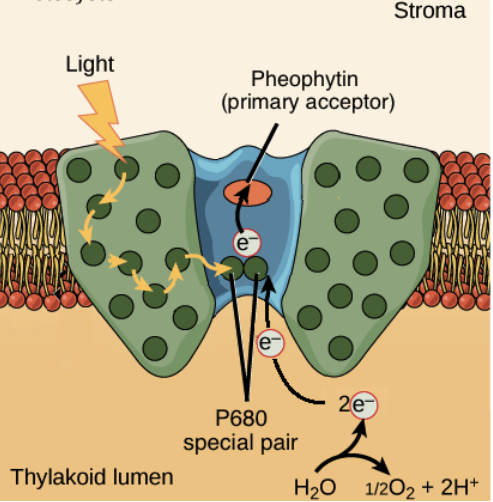
What is this a picture of?
photosystem II (PSII)
Inside of PSII, the _________-_________ P680, _________, has now become biology’s strongest ___________ agent → enough to __________ _______.
electron-deficient, P680+, oxidizing, oxidize H2O
When light hits and _______ P680 and it loses its electron it is called ________ (aka the _________ form). _______ wants electrons soooooooo bad, so it takes an electron from a nearby __________ residue which then loses a _______ to the _________ ________. This begins the building of the _______ ________. This __________ is now an extremely strong _____________ agent and works with the __________ __________ ___________ (______) to extract electrons out of _______. This happens ___ electron(s) at a time, so you go around this circle ___ times in order to produce a single _____ molecule, which is released and diffuses away.
excites, P680+, oxidized, P680+, tyrosine, proton, thylakoid lumen, proton gradient, tyrosine, oxidizing, oxygen evolving complex, OEC, H2O, 1, 4, O2
The _________ _________ _________ (_____), located within PSII, is a protein-bound cofactor containing 4 _____________ (____), 1 ___________ (____), and 5 ___________ (___).
oxygen evolving complex, OEC, manganese, Mn2+, calcium, Ca2+, oxygen, O
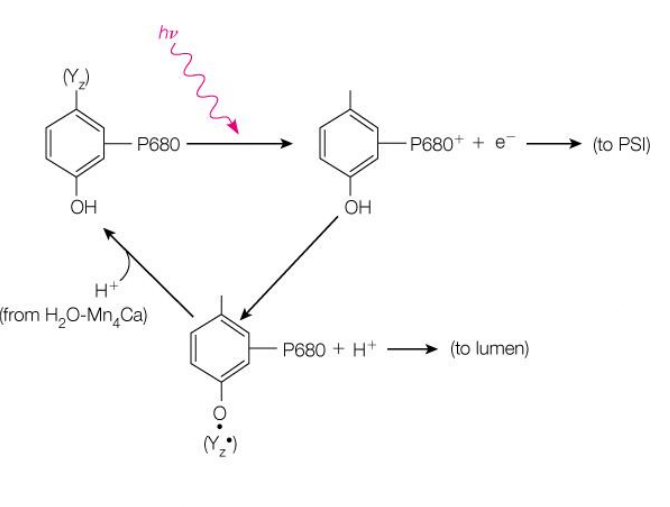
What process is shown here?
Where does it occur?
water-splitting, photosystem II (PSII)
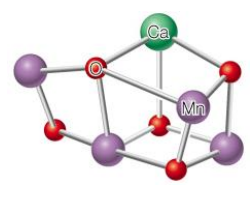
What is this a picture of?
Where is it located?
oxygen evolving complex (OEC), photosystem II (PSII)
The more _____________ the reduction potential, the higher the affinity of the ___________ form of the redox couple to accept electrons and become ___________
positive, oxidized, reduced
What is the standard reduction potential of the P680+/P680 redox pair per 1 electron?
+1.3
How is PSII able to pull electrons out of H2O?
P680+ is an extremely strong oxidizing agent with a more positive reduction potential than O2
After Qb is _________ with 2 electrons and dissociates from _____ as ______, it transfers the 2 electrons to _____________. The interaction between ______ and ______________ is very similar to the interaction between ______ and ______________ in mitochondria: ____________ behaves pretty much exactly the same as ____________. _______________ pumps ___ protons per split ______ into the ________ ________ using a ____ _______. The electrons are then passed by _______________ (similar to ______________ in mitochondria) to ______.
reduced, PSII, QH2, cytochrome b6f, QH2, cytochrome b6f, QH2, complex III, cytochrome b6f, complex III, cytochrome b6f, 4, H2O, thylakoid lumen, Q cycle, plastocyanin, cytochrome c, PSI
________________ in chloroplasts is very similar to ________________ in mitochondria as Q cycling and proton pumping occurs in both proteins.
cytochrome b6f, complex III
PSI transfers electrons from _____________ bound to the _________ _________ on the _______-facing side to ____________ located in the _________. The mechanisms is similar to PSII in that _________-mediated ___________ of ______ leads to electron transfer. Electrons from ____________ regenerate ______, completing electron transfer from _____ to _____.
plastocyanin, thylakoid membrane, lumen, ferredoxin, stroma, photon, excitation, P700, plastocyanin, P700, PSII, PSI
PSI is even bigger than PSII, with more than _____ ____________
160 chlorophylls
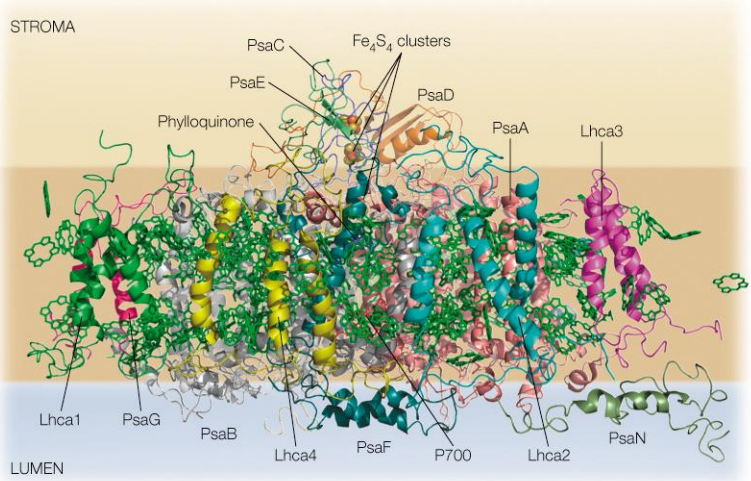
What is this a picture of?
photosystem I (PSI)
An electron first enters PSI from ______________, which is bound to the _________ _________ on the _______-facing side. The electron ___________ _______ into _______, which is an extremely strong ___________ agent; the electrons want to be anywhere BUT near _______. The electron moves through PSI using various ______-__________ _________ before ultimately ending up on the protein ____________, located in the _________. ____________ transfers its carried electrons to __________, located in __________________ ____________. This enzyme _________ ________ to ____________, thus generating the ___________ __________ required for the carbon reactions. This completes the _________ pathway.
plastocyanin, thylakoid membrane, lumen, excites P700, P700*, reducing, P700*, iron-sulfur clusters, ferredoxin, stroma, ferredoxin, NADP+, ferredoxin-NADP+ reductase, reduces NADP+, NADPH, reducing power, noncyclic
__________________ (___) is a soluble electron carrier that is the direct electron recipient → it can take the electrons in several different directions from there, responding to the ________ of the cell. For example, let’s say there is a low concentration of _______ in the cell meaning we have enough ________ and don’t need anymore reducing power. ______________ can send the electrons from _______ backwards through the _________ pathway, bypassing ________________ __________ entirely, sending these electrons back through _______________. This translocates __________, building up the _________ ________, thus generating more _____ without generating any _________. This helps balance ______ and ________ production for the carbon reactions.
ferredoxin, Fd, needs, NADP+, NADPH, ferredoxin, PSI, cyclic, ferredoxin-NADP+ reductase, cytochrome b6f, protons, proton gradient, ATP, NADPH, ATP, NADPH

What is this a picture of?
Where is it located?
ferredoxin (fd), stroma
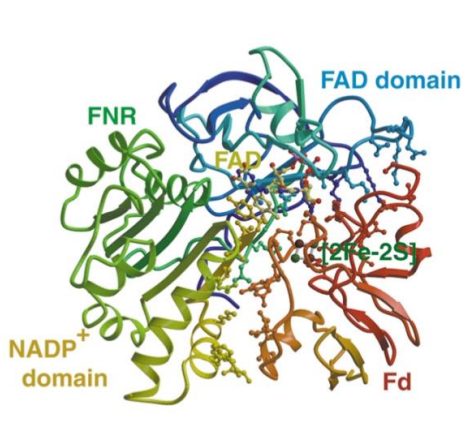
What is this a picture of?
Where is it located?
ferredoxin-NADP+ reductase, stroma
The _________ __________ produced by ____ (via ______-_______) and _____________ (via ____ ______) is used by ATP synthase to produce ATP.
proton gradient, PSII, water-splitting, cytochrome b6f, Q cycling
The thylakoid membrane is considerably more ________________ than the inner mitochondrial membrane, specifically to ______. This means that there is no __________ __________ between the thylakoid lumen and stroma, which allows the build up of a much greater ___________ __________, resulting in a much greater ____________ in ____ between the two environments.
permeable, ions, electrical gradient, chemical gradient, difference, pH
Per every 2H2O split (or per every 4 electrons), ~ ___ ATPs and ___ NADPHs are produced. This results in a total ___ ATPs produced (since the 2 NADPHs is worth about ______ ATPs). These ___ ATPs have an energy of about ______ kJ/mol. If we have 8 photons entering the chloroplast (4 at _______ nm, 4 at _______ nm), these photons have a total energy of about _________ kJ/mol. This means there is an efficiency of about _____%, which is actually pretty good, seeing as the best solar cells on the market range from ____% to ____% efficient. In terms of producing edible mass, the efficiency is about __%. So only __% of the energy from the sun goes towards making the “berry”, which makes sense because the plant ALSO has to make the roots, stems, leaves, etc.
4, 2, 9, 5-6, 9, 270, 680, 700, 1000, 27, 15, 23, 1, 1
Which ONE of the following statements is INCORRECT?
A. The so-called “dark-reactions” are accelerated by light.
B. Both atoms of oxygen in the O2 produced by photosynthesis come from water.
C. Photosynthesis in plants occurs in two stages. The first uses water to reduce CO2 to carbohydrates. The second uses NADPH to convert ADP into ATP.
D. Some organisms use hydrogen gas instead of water as a reducing agent.
C
Which ONE is the part of a chloroplast that absorbs the light used to power photosynthesis?
A. Chloroplast inner membrane
B. Thylakoid membrane
C. Stroma
D. Chloroplast outer membrane
B
Which ONE of the following describes how energy is transferred from antenna molecules to chlorophyll in the reaction center?
A. Emission of fluorescence that is absorbed by the chlorophyll in the reaction center
B. Electron transfer
C. Resonance transfer
D. Breaking a chemical bond and forming a new one
C
As described in section 15.3 of the textbook the quantum efficiency for photosynthesis decreases abruptly when the wavelength of light being used becomes longer the 680 nm. Which ONE of the following is the explanation for this “red drop”?
A. The reactions that extract electrons from water to make O2 take place in the photosystem that is activated by 680 nm light
B. Red light is absorbed by CO2 to initiate the synthesis of carbohydrates
C. Red light inhibits photosynthesis
D. Photosystem I requires 680 nm light
A
Which ONE of the following statements about protons and photosynthesis is correct?
A. The process of electron transport concentrates protons in the thylakoid lumen.
B. The process of electron transport does not cause translocation of protons.
C. The process of electron transport concentrates protons in the stroma.
D. The process of electron transport causes translocation of protons out of the chloroplast across the chloroplast inner and outer membrane into the cytoplasm of the cell.
A
Which ONE has the greatest need for an electron?
A. P680 in its electron-deficient state (P680+)
B. P680 in its excited state (P680*)
C. P700 in its electron-deficient state (P700+)
D. P700 in its excited state (P700*)
A
Which ONE has the lowest need for an electron?
A. P680 in its electron-deficient state (P680+)
B. P680 in its excited state (P680*)
C. P700 in its electron-deficient state (P700+)
D. P700 in its excited state (P700*)
D
Which ONE of the following is NOT a pair of molecules that have analogous functions in mitochondria and chloroplasts?
A. Plastoquinone and ubiquinone
B. Cytochrome c and plastocyanin
C. Q cycle and light
D. CF1 and F1
C
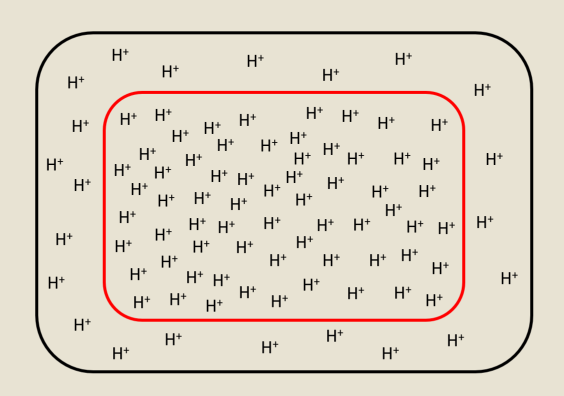
Each border represents a membrane in mitochondria and chloroplasts. Which membrane is represented by the red border?
A. inner mitochondrial membrane
B. outer mitochondrial membrane
C. thylakoid membrane
D. inner chloroplast membrane
E. outer chloroplast membrane
C
Which is the CORRECT order of electron carriers in the light reactions?
A. H2O → P680 → plastoquinone → plastocyanin → P700 → ferredoxin → NADPH
B. H2O → P680 → plastoquinone → plastocyanin → P700 → ferredoxin → NADH
C. H2O → P680 → coenzyme Q → cytochrome c → P700 → ferredoxin → NADPH
D. H2O → P700 → plastoquinone → plastocyanin → P680 → ferredoxin → NADPH
E. H2O → P700 → plastoquinone → plastocyanin → P680 → ferredoxin → NADH
A
Which is the CORRECT order of protein complexes in the light reactions?
A. light harvesting complex → PSI → cytochrome b6f → plastocyanin → PSII → ferredoxin → FNR
B. light harvesting complex → PSI → plastocyanin → cytochrome b6f → PSII → ferredoxin → FNR
C. PSI → light harvesting complex → plastocyanin → cytochrome b6f → PSII → ferredoxin → FNR
D. light harvesting complex → PSII → cytochrome b6f → plastocyanin → PSI → ferredoxin → FNR
E. PSII → cytochrome b6f → plastocyanin → PSI → light harvesting complex → FNR → ferredoxin
F. ferredoxin → FNR → PSI → plastocyanin → cytochrome b6f → PSII → light harvesting complex
D
Mn2+ is an important nutrient for plants, and yellowing between the veins of new leaves is a symptom of Mn2+ deficiency. Which process in photosynthesis is directly affected by this deficiency?
A. harvesting photons and getting them to the special pair in PSII
B. resupplying an electron to P680+ in PSII
C. pumping protons in cytochrome b6f
D. transferring electrons from cytochrome b6f to PSI
E. excitation of P700 in PSI
B
Which ONE of the following metal ion/protein pairs is NOT typically found in a normal cell? That is, which pairing is INCORRECT?
A. Fe2+: iron-sulfur protein
B. Fe2+: Cytochrome
C. Fe2+: hemoglobin
D. Mn2+: Photosystem II
E. Mn2+: light harvesting complexes
E
Fill in the blanks: The __________ generates more _________ at the expense of __________ when the cell has plenty of reducing power.
A. noncyclic pathway; ATP; NADPH
B. cyclic pathway; NADPH; ATP
C. cyclic pathway; ATP; NADPH
D. transfer of electrons from NADPH back to PSII; ATP; NADPH
E. transfer of electrons from Fd to NADP+; NADPH; ATP
C